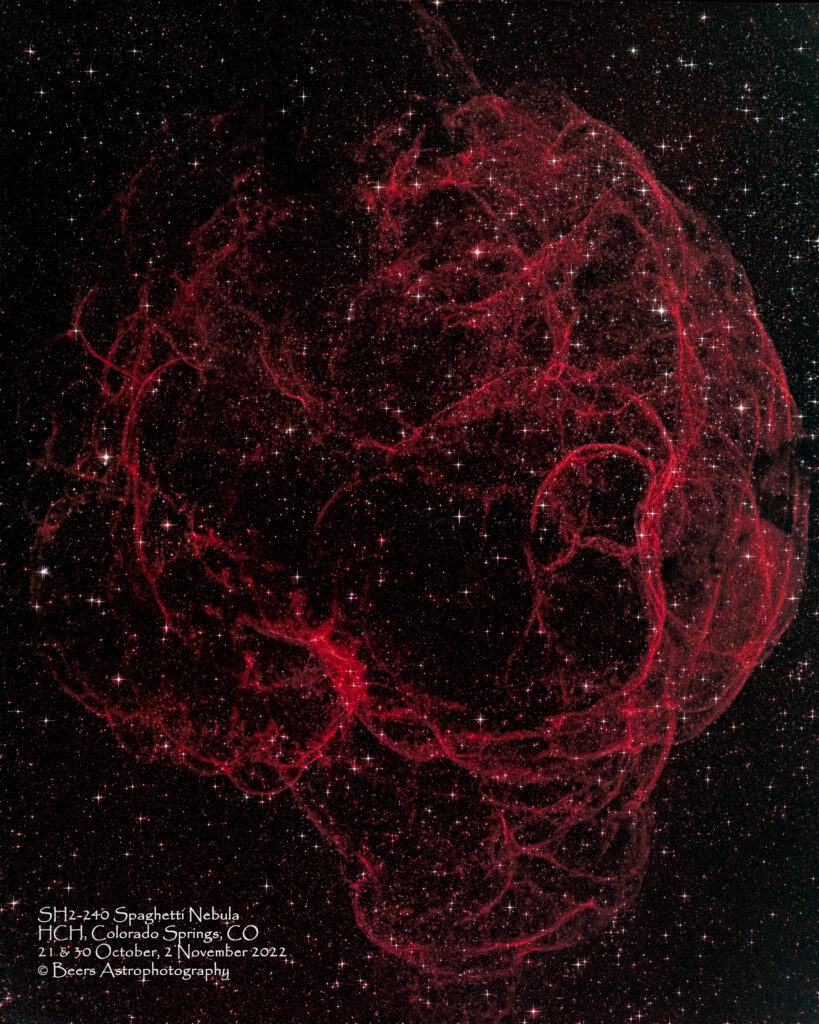
Fun facts
Simeis 147, also known as SH2-240 Spaghetti Nebula, is a supernova remnant (SNR) in the Milky Way, straddling the border between the constellations Auriga and Taurus. It was discovered in 1952 at the Crimean Astrophysical Observatory by Grigory Shajn and his team using a Schmidt camera and a narrowband filter close to the Hydrogen Alpha transmission line. It is difficult to observe due to its extremely low brightness. This discovery was part of a survey conducted between 1945 and 1955, most likely using captured German equipment, as the observatory was practically destroyed during WWII. The Schmidt camera had a field of view of 175′. Many previously unknown hydrogen nebula were discovered this way, as they are not readily visible in regular photographs.
The nebulous area has an almost spherical shell and a filamentary structure. The remnant has an apparent diameter of approximately 3 degrees, an estimated distance of approximately 3000 (±350) light-years, and an age of approximately 40,000 years. At that distance, it spans roughly 160 light years.
It is believed that the stellar explosion left behind a rapidly spinning neutron star known as pulsar PSR J0538+2817 in the nebula core, emitting a strong radio signal.
Other Catalog Designations: Simeis 147, Sharpless 2-240, SNR G180.0-01.7
Subtype: Supernova Remnant
Distance from Earth: 3000 light years
Visual Magnitude: 4.0
Apparent Dimensions: 3°20′ x 3°
Constellation: Taurus
{from: https://en.wikipedia.org/wiki/Simeis_147 }
Capture Notes
Spent three clear nights imaging the SH2-240 Spaghetti Nebula. It rises at about 2130, has a meridian flip at about 0400 and sets after sunrise. It is a large target that requires, even with the RaSC set-up a two-tile mosaic to capture the full target. So on 21 October, 30 October, and 2 November 2022 I imaged throughout the available time, splitting the imaging time roughly evenly between the two tiles.
Equipment
Polar alignment: QHYCCD camera (controlled by Polemaster)
Imaging stream: Askar FRA600, Canon EOS Ra with Optolong LeXtreme light pollution filter
Mount: Rainbow Astro RC-135E (controlled by iHubo)
Autoguider: Orion 60mm Multi-Use Guide Scope, Orion StarShoot AutoGuider Pro Mono Astrophotography Camera (controlled by PHD2)
All equipment controlled by HP Probook running Sequence Generator Pro v3.2.0.660.
Capture & processing notes
Sequence plan(s):
21October 2022: ISO1600. Tile 1: 40x300sec; captured 21Oct 2316 – 22Oct 0254 MDT; Total=3:20hrs. Tile2: 38x300sec; captured 22Oct 0257 – 0619 MDT; Total=3:10hrs.
30October 2022: ISO3200. Tile 1: 48x300sec; captured 30Oct 2214 – 31Oct 0224 MDT; Total=4hrs. Tile2: 41x300sec; captured 31Oct 0228 – 0623 MDT; Total=3:25hrs.
2November 2022: ISO3200. Tile 1: 24x600sec; captured 2Nov 2215 – 3Nov 0220 MDT; Total=4hrs. Tile2: 22x600sec; captured 3Nov 0223 – 0635 MDT; Total=3:40hrs.
Total integration time: Tile 1 = 11:20hrs; Tile 2 = 10:15 hrs
Shooting location: HCH, Colorado Springs, Colorado
Processing: Stacked each tile as three session in APP. Used Ha-OIII Color for stacking algorithm, due to use of LeX light pollution filter. Created mosaic from the three-session .fits files. Processed in LR/PS.
